Home / Reactions of Diazonium Salts: Sandmeyer and Related Reactions
Amines
Reactions of Diazonium Salts: Sandmeyer and Related Reactions
Last updated: February 28th, 2025 |
Diazonium Salts From Amines, And Reactions Of Diazonium Salts
Today let’s talk about a set of reactions of aromatic amines, that variously are catalogued under “amines” and “aromatic compounds”, depending on the textbook.
It involves converting an aromatic amino group (NH2) into a tremendously good leaving group (N2) which can then be replaced by various nucleophiles. However, N2 is such a good leaving group that the method only works well for aromatic amines; alkyl (“aliphatic”) amines tend to lose N2 too rapidly, making the method much less useful in that case.
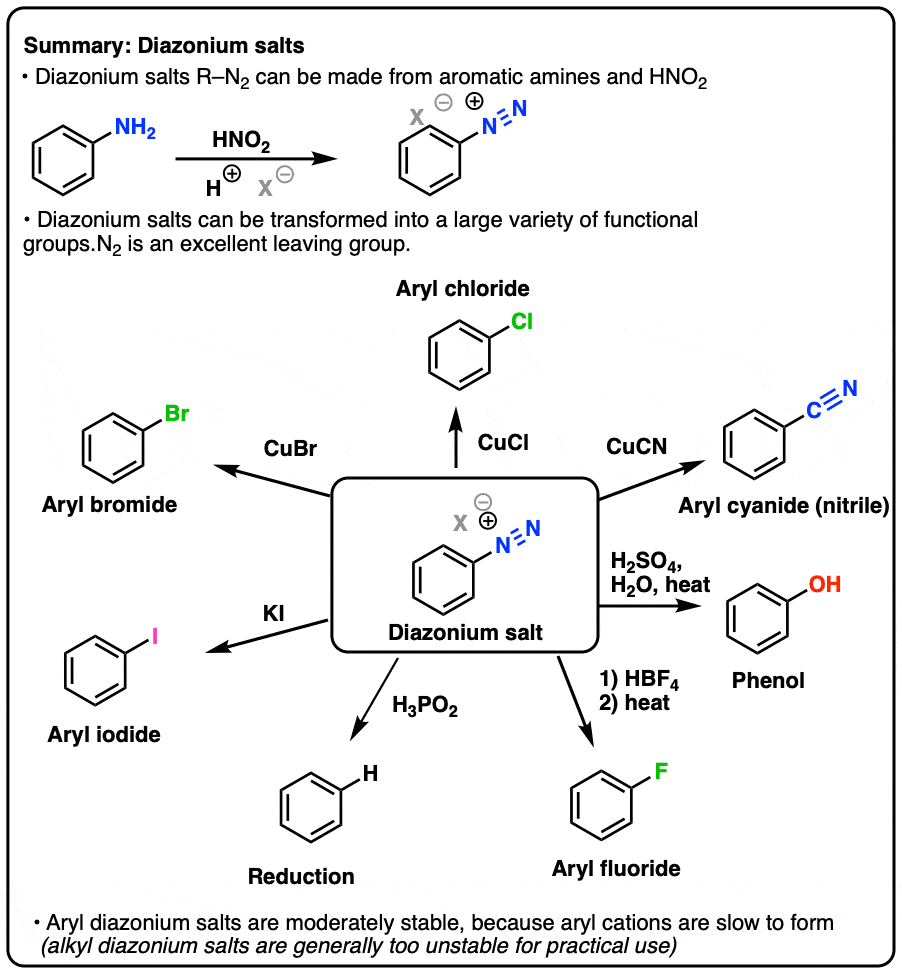
Table of Contents
- Formation of Diazonium Salts From Aromatic Amines
- Reactions of Diazonium Salts: Sandmeyer And Other Reactions
- Mechanism: Formation of Diazonium Ions
- Bonus Reaction: Diazo Coupling
- Notes
- Quiz Yourself!
- (Advanced) References and Further Reading
1. Formation of Diazonium Salts From Aromatic Amines
Here’s the process. Treatment of an aromatic amine with nitrous acid (or sodium nitrite, which is converted to nitrous acid in the presence of acid) in the presence of a strong acid like HCl results in the loss of H2O and the formation of a new N-N triple bond. The resulting species is called a “diazonium ion”:
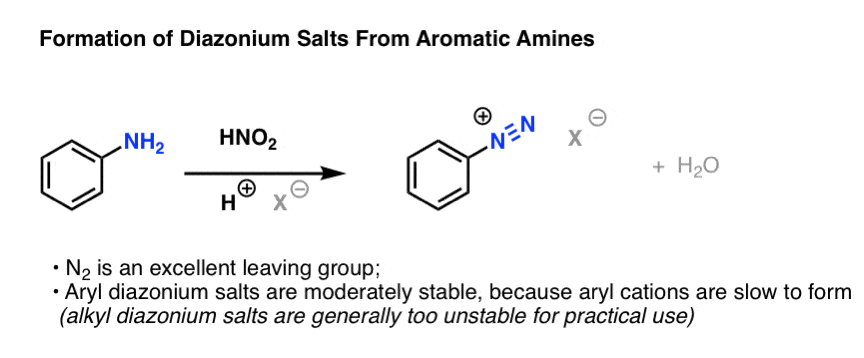
(How does it work? We’ll go through the mechanism at the bottom of the post).
2. Reactions of Diazonium Salts: Overview
So why does it matter?
It matters because the resulting diazonium salts can be transformed into all kinds of useful functional groups. Rather than describe everything in words, first let’s just show 7 examples with a diagram:
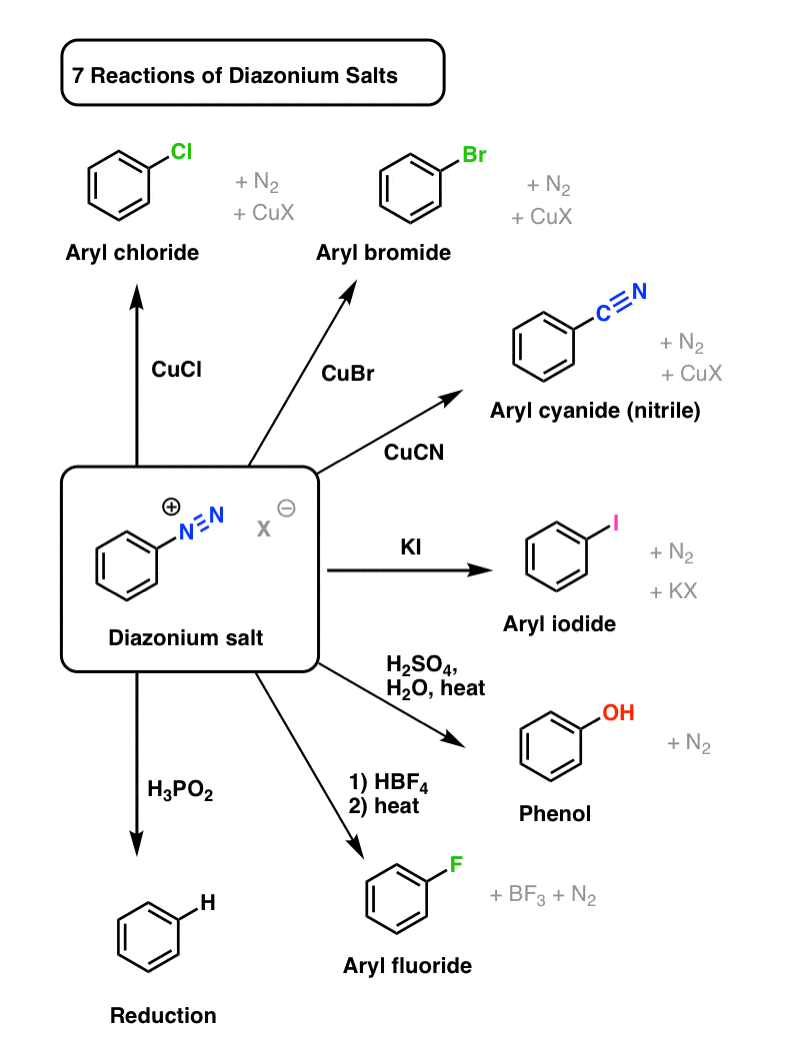
Any process featuring a single starting material that can be transformed into seven different potential products can be reasonably described as “versatile”.
These reactions can be roughly divided into two categories: Sandmeyer reactions, and everything else.
Sandmeyer Reactions
One way to transform diazonium salts is by treating them with various compounds of copper. These are known as Sandmeyer reactions, after Traugott Sandmeyer who first discovered the reaction in 1884 (with copper acetylide!).
Three key examples are:
- CuCl transforms aryl diazonium salts into aryl chlorides
- CuBr transforms aryl diazonium salts into aryl bromides
- CuCN transforms aryl diazonium salts into aryl cyanides (nitriles).
The mechanism, which you can read about elsewhere, likely proceeds through an aryl radical, which is oxidized to an aryl cation and then attacked by a nucleophile.
Other Reactions
Copper isn’t necessary for substitution to occur if a strong enough nucleophile is present, or if the mixture is heated enough:
- Aryl iodides can also be obtained from aryl diazonium salts, through treatment with potassium iodide (KI).
- Hydroxyl groups (OH) can be installed on an aryl diazonium salt through heating with water and acid. (we’ve previously seen one example in John Roberts’ work on arynes, which we covered here. )
- Aryl fluorides can be installed through a two step process. The first involves exchanging the counterion (X–) on the aryl diazonium salt with the tetrafluoroborate (BF4–) ion by treating the diazonium salt with HBF4. Then, when heated, fluorine can act as a nucleophile, displacing N2 and releasing BF3 as a byproduct.
- The diazonium salt can also be reduced to C–H, by treating the aryl diazonium salt with hypophosphorous acid (H3PO2).
Not so bad from a single functional group!
3. Mechanism: Formation of Diazonium Ions
Part 1: Formation of nitrosonium ion from HNO2
Now let’s dig into how some of these reactions work.
First, let’s go through formation of the diazonium salt, a process called “diazotization”.
The first key reagent for this process is either sodium nitrite (NaNO2) or nitrous acid (HNO2). Sodium nitrite has the advantage of being an easily handled salt, while HNO2 is a somewhat unstable liquid.
The second key reagent is a strong mineral acid like HCl; if NaNO2 is used, HCl converts it into HNO2.

The key purpose of HCl is to further convert HNO2 into the powerful electrophile NO+, the “nitrosonium ion“, which is the key electrophile in the reaction that forms the diazonium salt.
The nitrosonium ion is formed through protonation of OH and resultant loss of water:
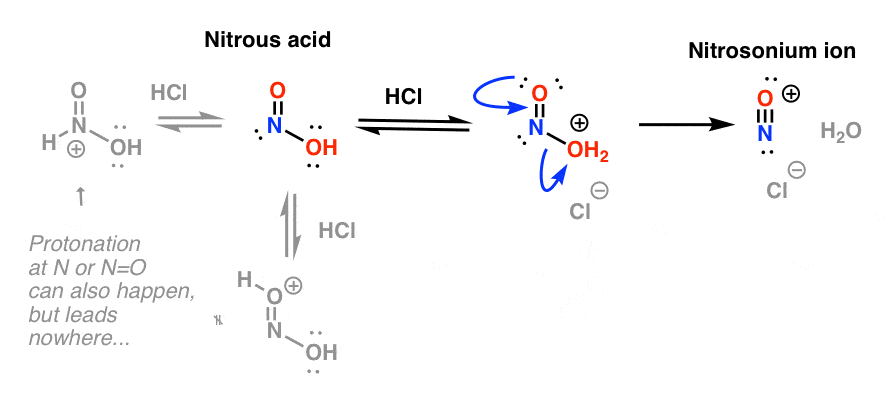
Part 2: Formation of the diazonium ion
The next step is formation of the diazonium ion from the reaction between the amine and the nitrosonium ion, which also requires acid.
How does it work?
The first step is formation of a new N–N bond, which occurs through attack of the nitrosonium ion by the aromatic amine (Step 1). This is followed by two proton transfers from nitrogen to oxygen (Steps 2 and 3) accompanied by reorganization of the pi bonding framework [forming N–N (pi), breaking N–O (pi) ]. The final step is formation of the nitrogen-nitrogen triple bond accompanied by expulsion of water (Step 4).
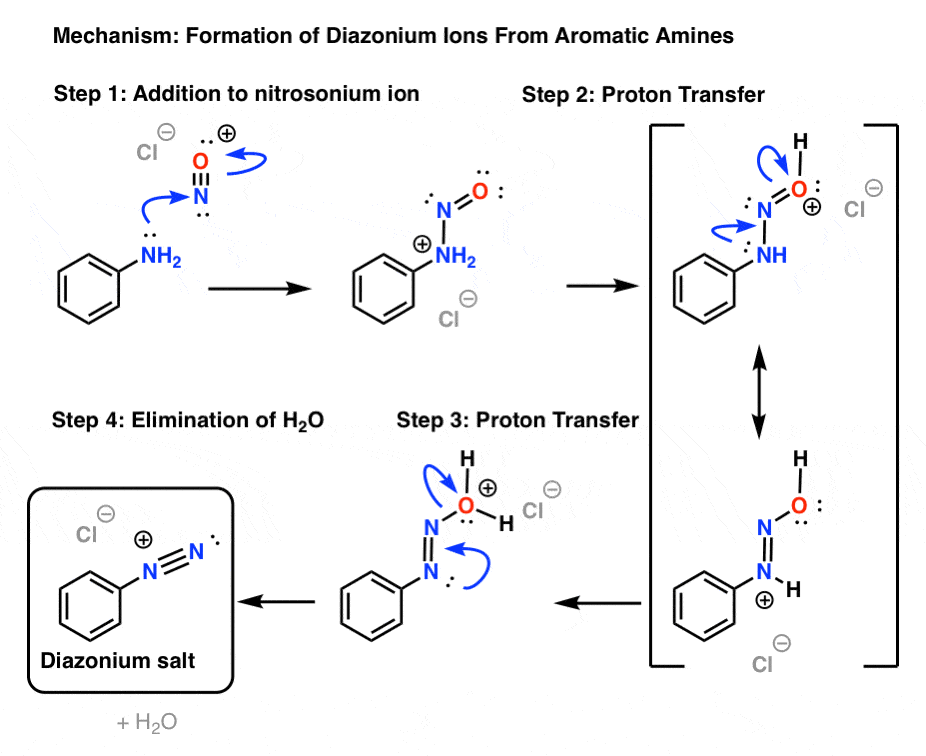
Being fairly unstable (and potentially explosive), diazonium salts are typically not isolated (it’s relatively safe to handle the tetrafluoroborate salts as solids, but that’s about it). Once formed, they’re usually treated immediately with the appropriate reagent en route to the desired product.
4. Bonus Reaction: Diazo Coupling
There’s one last reaction of diazonium salts which is worth mentioning. A surprising number of dyes in our daily experience are derivatives of diazobenzene, the essential structure of which is two benzene molecules joined by a nitrogen-nitrogen double bond. See this article on azo dyes, for instance. Yellow, red, and orange are common colors of azo dyes.
Azo dyes are made through the reaction of an electron-rich aromatic partner with a diazonium salt. Only electron-rich aromatic species are good enough nucleophiles to attack diazonium salts.
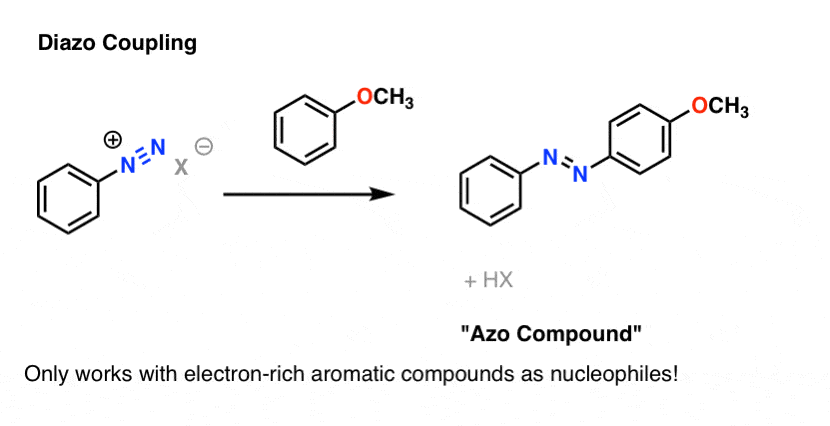
Notes
Related Articles
- Nucleophilic Aromatic Substitution (2) – The Benzyne Mechanism
- Nucleophilic Aromatic Substitution (NAS)
- Understanding Ortho, Para, and Meta Directors
- Aromatic Synthesis (1) – “Order Of Operations”
- Synthesis (7): Reaction Map of Benzene and Related Aromatic Compounds
- More Reactions on the Aromatic Sidechain: Reduction of Nitro Groups and the Baeyer Villiger
Quiz Yourself!
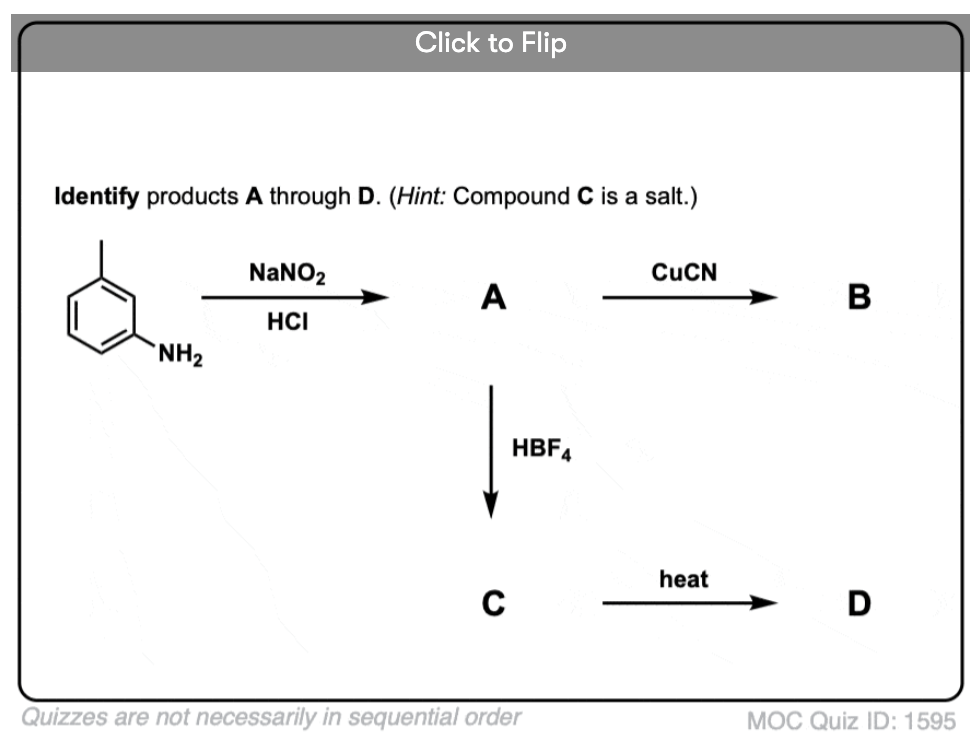
Become a MOC member to see the clickable quiz with answers on the back.
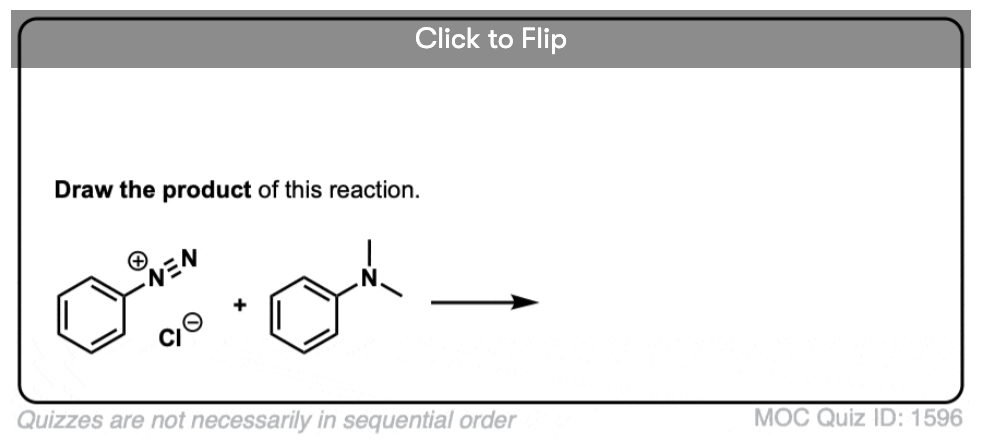
Become a MOC member to see the clickable quiz with answers on the back.
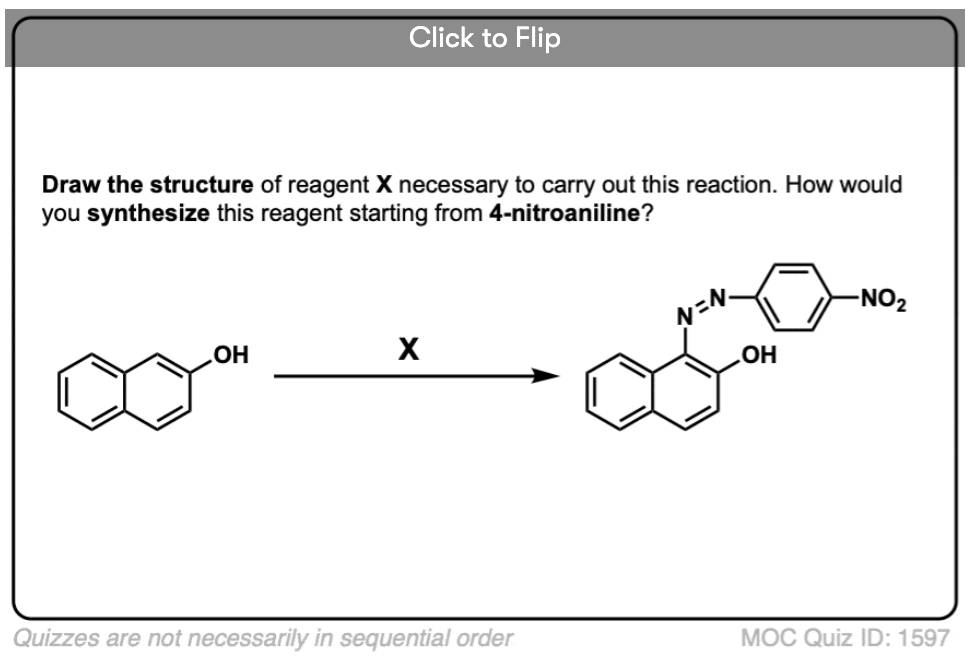
Become a MOC member to see the clickable quiz with answers on the back.
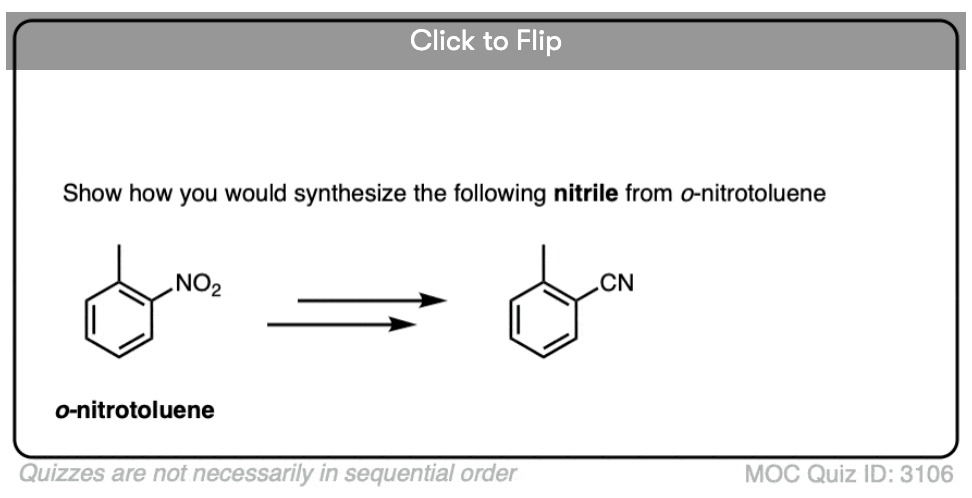
Become a MOC member to see the clickable quiz with answers on the back.
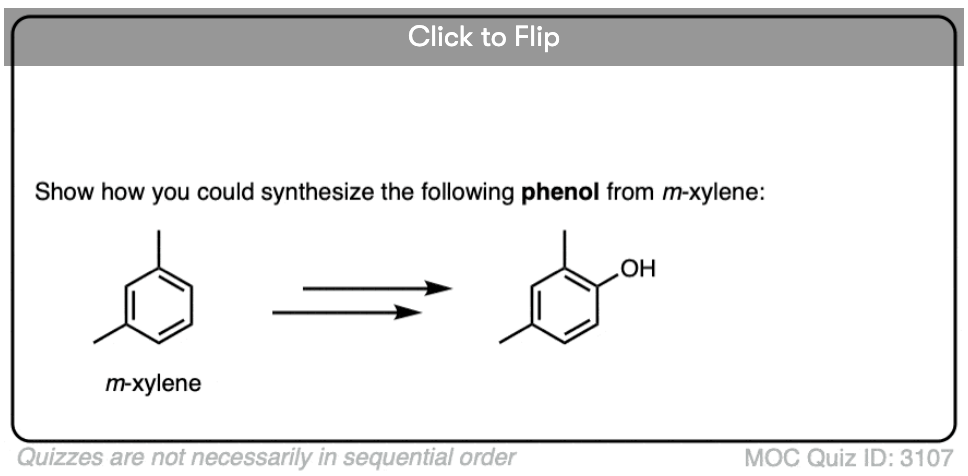
Become a MOC member to see the clickable quiz with answers on the back.
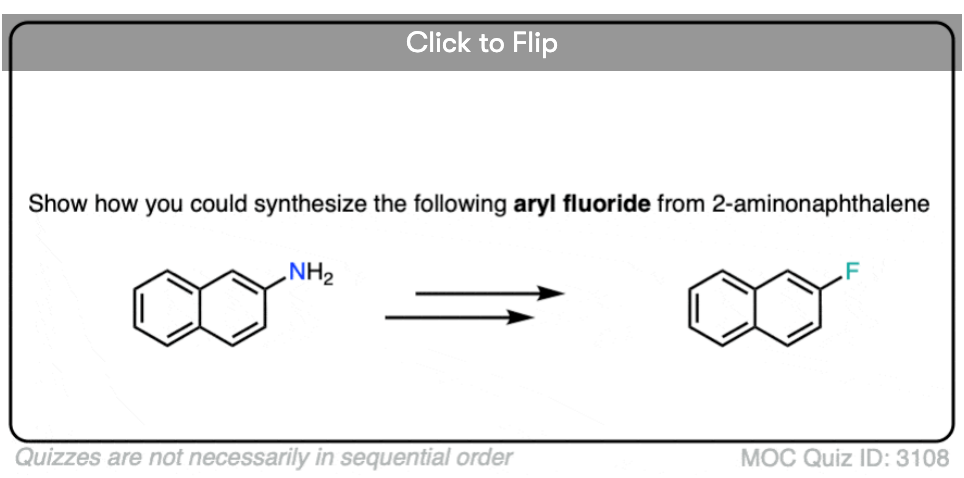
Become a MOC member to see the clickable quiz with answers on the back.
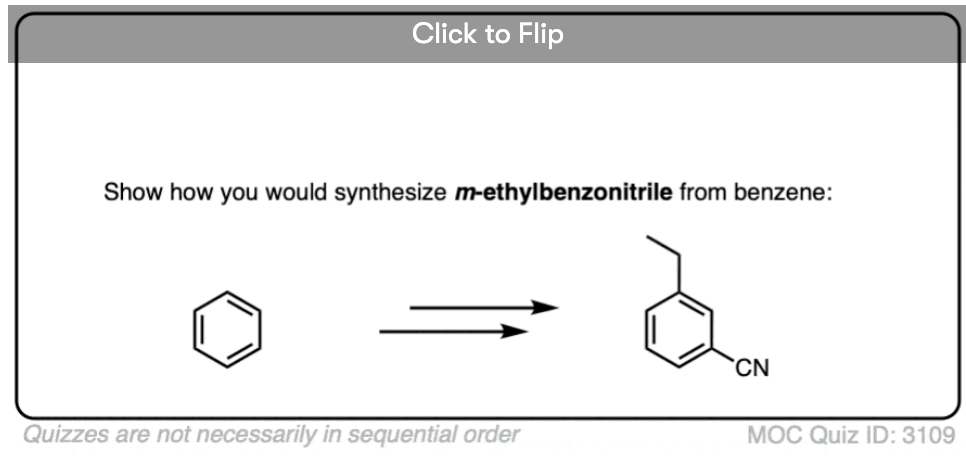
Become a MOC member to see the clickable quiz with answers on the back.
(Advanced) References and Further Reading
- Ueber die Ersetzung der Amidgruppe durch Chlor in den aromatischen Substanzen
Traugott Sandmeyer
Ber. 1884 17 (2), 1633-1635
DOI: 10.1002/cber.18840170219
This paper describes the accidental discovery of the Sandmeyer reaction by T. Sandmeyer. He was attempting to synthesize phenylacetylene by combining benzenediazonium chloride and cuprous acetylide, and instead obtained chlorobenzene. - Ueber die Ersetzung der Amid‐gruppe durch Chlor, Brom und Cyan in den aromatischen Substanzen
Traugott Sandmeyer
Ber. 1884 17 (2), 2650-2653
DOI: 10.1002/cber.188401702202
Sandmeyer generalizes the reaction to include the syntheses of bromobenzene and benzonitrile using CuBr and CuCN. - The Sandmeyer Reaction.
Herbert H. Hodgson
Chemical Reviews 1947, 40 (2), 251-277
DOI: 10.1021/cr60126a003
This is an old review, useful if you want to look for some of the original references for this chemistry. - Über aromatische Fluorverbindungen, I.: Ein neues Verfahren zu ihrer Darstellung
Günther Balz, Günther Schiemann
Ber. 1927, 60 (5), 1186-1190
DOI: 10.1002/cber.19270600539
The formation of aryl fluorides from the decomposition of aryldiazonium tetrafluoroborates is now known as the Balz-Schiemann reaction, after the chemists who first described the reaction. - The Mechanism of the Sandmeyer and Meerwein Reactions
Jay K. Kochi
Journal of the American Chemical Society 1957, 79 (11), 2942-2948
DOI: 10.1021/ja01568a066
Kochi was an eminent physical organic chemist in the 20th century. In this paper, he examines the mechanism of the Sandmeyer reaction, providing further proof that it proceeds through an aryl radical intermediate. - Radical reactions of arenediazonium ions: An easy entry into the chemistry of the aryl radical
Carlo Galli
Chemical Reviews 1988, 88 (5), 765-792
DOI: 10.1021/cr00087a004
This review covers the results of various investigations on the mechanism of the Sandmeyer and related reactions – these are proposed to go through aryl radical intermediates. - An investigation of the two-step nature of the Sandmeyer reaction
Carlo Galli
Chem. Soc., Perkin Trans. 2, 1981, 1459-1461
DOI: 10.1039/P29810001459
The role of Cu salts in the Sandmeyer reaction is to transfer an electron to the intermediate aryl cation, forming an aryl radical. If this is true, then other metal salts and compounds (e.g. ferrocene) should be able to reduce diazonium salts, and this is examined here. - The Hypophosphorous Acid Deamination of Diazonium Salts in Deuterium Oxide
Elliot R. Alexander and Robert E. Burge Jr.
Journal of the American Chemical Society 1950, 72 (7), 3100-3103
DOI: 10.1021/ja01163a082
While the reduction of arenediazonium salts with H3PO3 may seem like a useless reaction, this paper shows a very useful application – if you do this in D2O, you can do ipso-deuteration! - A simple preparation of phenols from diazonium ions via the generation and oxidation of aryl radicals by copper salts
Theodore Cohen, Albert G. Dietz Jr., and Jane R. Miser
The Journal of Organic Chemistry 1977, 42 (12), 2053-2058
DOI: 10.1021/jo00432a003
As the introduction of this paper states, the conversion of aryldiazonium ions to phenols is simple on paper but not necessarily in practice. High acidity is required to suppress side reactions, such as azo coupling. The use of Cu salts for this reaction as well allows cleaner reactions, higher yields, and simplified workup. - Mechanism of formation of aryl fluorides from arenediazonium fluoborates
Gardner Swain and Randall J. Rogers
Journal of the American Chemical Society 1975, 97 (4), 799-800
DOI: 10.1021/ja00837a019
An elegant kinetic study to determine the mechanism of the Balz-Schiemann reaction. Because of the insensitivity of the product distribution to excess BF3, it is proposed that the fluorobenzene is formed by direct capture from BF4– by the Ar+ intermediate formed by dediazonization. This would be a tight ion pair in solution, and quite favorable entropically as well. - FLUOROBENZENE
T. Flood
Org. Synth. 1933, 13, 46
DOI: 10.15227/orgsyn.013.0046
A standard procedure for a Balz-Schiemann reaction. - Reactivity and stability of arenediazonium ions
Heinrich Zollinger
Accounts of Chemical Research 1973, 6 (10), 335-341
DOI: 10.1021/ar50070a002
Prof. Zollinger (ETH Zurich) was the guru of diazonium ion chemistry, and this review covers a lot of work on the various reactions of aryldiazonium ions.
00 General Chemistry Review
01 Bonding, Structure, and Resonance
- How Do We Know Methane (CH4) Is Tetrahedral?
- Hybrid Orbitals and Hybridization
- How To Determine Hybridization: A Shortcut
- Orbital Hybridization And Bond Strengths
- Sigma bonds come in six varieties: Pi bonds come in one
- A Key Skill: How to Calculate Formal Charge
- The Four Intermolecular Forces and How They Affect Boiling Points
- 3 Trends That Affect Boiling Points
- How To Use Electronegativity To Determine Electron Density (and why NOT to trust formal charge)
- Introduction to Resonance
- How To Use Curved Arrows To Interchange Resonance Forms
- Evaluating Resonance Forms (1) - The Rule of Least Charges
- How To Find The Best Resonance Structure By Applying Electronegativity
- Evaluating Resonance Structures With Negative Charges
- Evaluating Resonance Structures With Positive Charge
- Exploring Resonance: Pi-Donation
- Exploring Resonance: Pi-acceptors
- In Summary: Evaluating Resonance Structures
- Drawing Resonance Structures: 3 Common Mistakes To Avoid
- How to apply electronegativity and resonance to understand reactivity
- Bond Hybridization Practice
- Structure and Bonding Practice Quizzes
- Resonance Structures Practice
02 Acid Base Reactions
- Introduction to Acid-Base Reactions
- Acid Base Reactions In Organic Chemistry
- The Stronger The Acid, The Weaker The Conjugate Base
- Walkthrough of Acid-Base Reactions (3) - Acidity Trends
- Five Key Factors That Influence Acidity
- Acid-Base Reactions: Introducing Ka and pKa
- How to Use a pKa Table
- The pKa Table Is Your Friend
- A Handy Rule of Thumb for Acid-Base Reactions
- Acid Base Reactions Are Fast
- pKa Values Span 60 Orders Of Magnitude
- How Protonation and Deprotonation Affect Reactivity
- Acid Base Practice Problems
03 Alkanes and Nomenclature
- Meet the (Most Important) Functional Groups
- Condensed Formulas: Deciphering What the Brackets Mean
- Hidden Hydrogens, Hidden Lone Pairs, Hidden Counterions
- Don't Be Futyl, Learn The Butyls
- Primary, Secondary, Tertiary, Quaternary In Organic Chemistry
- Branching, and Its Affect On Melting and Boiling Points
- The Many, Many Ways of Drawing Butane
- Wedge And Dash Convention For Tetrahedral Carbon
- Common Mistakes in Organic Chemistry: Pentavalent Carbon
- Table of Functional Group Priorities for Nomenclature
- Summary Sheet - Alkane Nomenclature
- Organic Chemistry IUPAC Nomenclature Demystified With A Simple Puzzle Piece Approach
- Boiling Point Quizzes
- Organic Chemistry Nomenclature Quizzes
04 Conformations and Cycloalkanes
- Staggered vs Eclipsed Conformations of Ethane
- Conformational Isomers of Propane
- Newman Projection of Butane (and Gauche Conformation)
- Introduction to Cycloalkanes
- Geometric Isomers In Small Rings: Cis And Trans Cycloalkanes
- Calculation of Ring Strain In Cycloalkanes
- Cycloalkanes - Ring Strain In Cyclopropane And Cyclobutane
- Cyclohexane Conformations
- Cyclohexane Chair Conformation: An Aerial Tour
- How To Draw The Cyclohexane Chair Conformation
- The Cyclohexane Chair Flip
- The Cyclohexane Chair Flip - Energy Diagram
- Substituted Cyclohexanes - Axial vs Equatorial
- Ranking The Bulkiness Of Substituents On Cyclohexanes: "A-Values"
- Cyclohexane Chair Conformation Stability: Which One Is Lower Energy?
- Fused Rings - Cis-Decalin and Trans-Decalin
- Naming Bicyclic Compounds - Fused, Bridged, and Spiro
- Bredt's Rule (And Summary of Cycloalkanes)
- Newman Projection Practice
- Cycloalkanes Practice Problems
05 A Primer On Organic Reactions
- The Most Important Question To Ask When Learning a New Reaction
- Curved Arrows (for reactions)
- Nucleophiles and Electrophiles
- The Three Classes of Nucleophiles
- Nucleophilicity vs. Basicity
- What Makes A Good Nucleophile?
- What Makes A Good Leaving Group?
- 3 Factors That Stabilize Carbocations
- Equilibrium and Energy Relationships
- 7 Factors that stabilize negative charge in organic chemistry
- 7 Factors That Stabilize Positive Charge in Organic Chemistry
- What's a Transition State?
- Hammond's Postulate
- Learning Organic Chemistry Reactions: A Checklist (PDF)
- Introduction to Oxidative Cleavage Reactions
06 Free Radical Reactions
- Bond Dissociation Energies = Homolytic Cleavage
- Free Radical Reactions
- 3 Factors That Stabilize Free Radicals
- What Factors Destabilize Free Radicals?
- Bond Strengths And Radical Stability
- Free Radical Initiation: Why Is "Light" Or "Heat" Required?
- Initiation, Propagation, Termination
- Monochlorination Products Of Propane, Pentane, And Other Alkanes
- Selectivity In Free Radical Reactions
- Selectivity in Free Radical Reactions: Bromination vs. Chlorination
- Halogenation At Tiffany's
- Allylic Bromination
- Bonus Topic: Allylic Rearrangements
- In Summary: Free Radicals
- Synthesis (2) - Reactions of Alkanes
- Free Radicals Practice Quizzes
07 Stereochemistry and Chirality
- Types of Isomers: Constitutional Isomers, Stereoisomers, Enantiomers, and Diastereomers
- How To Draw The Enantiomer Of A Chiral Molecule
- How To Draw A Bond Rotation
- Introduction to Assigning (R) and (S): The Cahn-Ingold-Prelog Rules
- Assigning Cahn-Ingold-Prelog (CIP) Priorities (2) - The Method of Dots
- Enantiomers vs Diastereomers vs The Same? Two Methods For Solving Problems
- Assigning R/S To Newman Projections (And Converting Newman To Line Diagrams)
- How To Determine R and S Configurations On A Fischer Projection
- The Meso Trap
- Optical Rotation, Optical Activity, and Specific Rotation
- Optical Purity and Enantiomeric Excess
- What's a Racemic Mixture?
- Chiral Allenes And Chiral Axes
- Stereochemistry Practice Problems and Quizzes
08 Substitution Reactions
- Nucleophilic Substitution Reactions - Introduction
- Two Types of Nucleophilic Substitution Reactions
- The SN2 Mechanism
- Why the SN2 Reaction Is Powerful
- The SN1 Mechanism
- The Conjugate Acid Is A Better Leaving Group
- Comparing the SN1 and SN2 Reactions
- Polar Protic? Polar Aprotic? Nonpolar? All About Solvents
- Steric Hindrance is Like a Fat Goalie
- Common Blind Spot: Intramolecular Reactions
- Substitution Practice - SN1
- Substitution Practice - SN2
09 Elimination Reactions
- Elimination Reactions (1): Introduction And The Key Pattern
- Elimination Reactions (2): The Zaitsev Rule
- Elimination Reactions Are Favored By Heat
- Two Elimination Reaction Patterns
- The E1 Reaction
- The E2 Mechanism
- E1 vs E2: Comparing the E1 and E2 Reactions
- Antiperiplanar Relationships: The E2 Reaction and Cyclohexane Rings
- Bulky Bases in Elimination Reactions
- Comparing the E1 vs SN1 Reactions
- Elimination (E1) Reactions With Rearrangements
- E1cB - Elimination (Unimolecular) Conjugate Base
- Elimination (E1) Practice Problems And Solutions
- Elimination (E2) Practice Problems and Solutions
10 Rearrangements
11 SN1/SN2/E1/E2 Decision
- Identifying Where Substitution and Elimination Reactions Happen
- Deciding SN1/SN2/E1/E2 (1) - The Substrate
- Deciding SN1/SN2/E1/E2 (2) - The Nucleophile/Base
- SN1 vs E1 and SN2 vs E2 : The Temperature
- Deciding SN1/SN2/E1/E2 - The Solvent
- Wrapup: The Key Factors For Determining SN1/SN2/E1/E2
- Alkyl Halide Reaction Map And Summary
- SN1 SN2 E1 E2 Practice Problems
12 Alkene Reactions
- E and Z Notation For Alkenes (+ Cis/Trans)
- Alkene Stability
- Alkene Addition Reactions: "Regioselectivity" and "Stereoselectivity" (Syn/Anti)
- Stereoselective and Stereospecific Reactions
- Hydrohalogenation of Alkenes and Markovnikov's Rule
- Hydration of Alkenes With Aqueous Acid
- Rearrangements in Alkene Addition Reactions
- Halogenation of Alkenes and Halohydrin Formation
- Oxymercuration Demercuration of Alkenes
- Hydroboration Oxidation of Alkenes
- m-CPBA (meta-chloroperoxybenzoic acid)
- OsO4 (Osmium Tetroxide) for Dihydroxylation of Alkenes
- Palladium on Carbon (Pd/C) for Catalytic Hydrogenation of Alkenes
- Cyclopropanation of Alkenes
- A Fourth Alkene Addition Pattern - Free Radical Addition
- Alkene Reactions: Ozonolysis
- Summary: Three Key Families Of Alkene Reaction Mechanisms
- Synthesis (4) - Alkene Reaction Map, Including Alkyl Halide Reactions
- Alkene Reactions Practice Problems
13 Alkyne Reactions
- Acetylides from Alkynes, And Substitution Reactions of Acetylides
- Partial Reduction of Alkynes With Lindlar's Catalyst
- Partial Reduction of Alkynes With Na/NH3 To Obtain Trans Alkenes
- Alkyne Hydroboration With "R2BH"
- Hydration and Oxymercuration of Alkynes
- Hydrohalogenation of Alkynes
- Alkyne Halogenation: Bromination, Chlorination, and Iodination of Alkynes
- Alkyne Reactions - The "Concerted" Pathway
- Alkenes To Alkynes Via Halogenation And Elimination Reactions
- Alkynes Are A Blank Canvas
- Synthesis (5) - Reactions of Alkynes
- Alkyne Reactions Practice Problems With Answers
14 Alcohols, Epoxides and Ethers
- Alcohols - Nomenclature and Properties
- Alcohols Can Act As Acids Or Bases (And Why It Matters)
- Alcohols - Acidity and Basicity
- The Williamson Ether Synthesis
- Ethers From Alkenes, Tertiary Alkyl Halides and Alkoxymercuration
- Alcohols To Ethers via Acid Catalysis
- Cleavage Of Ethers With Acid
- Epoxides - The Outlier Of The Ether Family
- Opening of Epoxides With Acid
- Epoxide Ring Opening With Base
- Making Alkyl Halides From Alcohols
- Tosylates And Mesylates
- PBr3 and SOCl2
- Elimination Reactions of Alcohols
- Elimination of Alcohols To Alkenes With POCl3
- Alcohol Oxidation: "Strong" and "Weak" Oxidants
- Demystifying The Mechanisms of Alcohol Oxidations
- Protecting Groups For Alcohols
- Thiols And Thioethers
- Calculating the oxidation state of a carbon
- Oxidation and Reduction in Organic Chemistry
- Oxidation Ladders
- SOCl2 Mechanism For Alcohols To Alkyl Halides: SN2 versus SNi
- Alcohol Reactions Roadmap (PDF)
- Alcohol Reaction Practice Problems
- Epoxide Reaction Quizzes
- Oxidation and Reduction Practice Quizzes
15 Organometallics
- What's An Organometallic?
- Formation of Grignard and Organolithium Reagents
- Organometallics Are Strong Bases
- Reactions of Grignard Reagents
- Protecting Groups In Grignard Reactions
- Synthesis Problems Involving Grignard Reagents
- Grignard Reactions And Synthesis (2)
- Organocuprates (Gilman Reagents): How They're Made
- Gilman Reagents (Organocuprates): What They're Used For
- The Heck, Suzuki, and Olefin Metathesis Reactions (And Why They Don't Belong In Most Introductory Organic Chemistry Courses)
- Reaction Map: Reactions of Organometallics
- Grignard Practice Problems
16 Spectroscopy
- Degrees of Unsaturation (or IHD, Index of Hydrogen Deficiency)
- Conjugation And Color (+ How Bleach Works)
- Introduction To UV-Vis Spectroscopy
- UV-Vis Spectroscopy: Absorbance of Carbonyls
- UV-Vis Spectroscopy: Practice Questions
- Bond Vibrations, Infrared Spectroscopy, and the "Ball and Spring" Model
- Infrared Spectroscopy: A Quick Primer On Interpreting Spectra
- IR Spectroscopy: 4 Practice Problems
- 1H NMR: How Many Signals?
- Homotopic, Enantiotopic, Diastereotopic
- Diastereotopic Protons in 1H NMR Spectroscopy: Examples
- 13-C NMR - How Many Signals
- Liquid Gold: Pheromones In Doe Urine
- Natural Product Isolation (1) - Extraction
- Natural Product Isolation (2) - Purification Techniques, An Overview
- Structure Determination Case Study: Deer Tarsal Gland Pheromone
17 Dienes and MO Theory
- What To Expect In Organic Chemistry 2
- Are these molecules conjugated?
- Conjugation And Resonance In Organic Chemistry
- Bonding And Antibonding Pi Orbitals
- Molecular Orbitals of The Allyl Cation, Allyl Radical, and Allyl Anion
- Pi Molecular Orbitals of Butadiene
- Reactions of Dienes: 1,2 and 1,4 Addition
- Thermodynamic and Kinetic Products
- More On 1,2 and 1,4 Additions To Dienes
- s-cis and s-trans
- The Diels-Alder Reaction
- Cyclic Dienes and Dienophiles in the Diels-Alder Reaction
- Stereochemistry of the Diels-Alder Reaction
- Exo vs Endo Products In The Diels Alder: How To Tell Them Apart
- HOMO and LUMO In the Diels Alder Reaction
- Why Are Endo vs Exo Products Favored in the Diels-Alder Reaction?
- Diels-Alder Reaction: Kinetic and Thermodynamic Control
- The Retro Diels-Alder Reaction
- The Intramolecular Diels Alder Reaction
- Regiochemistry In The Diels-Alder Reaction
- The Cope and Claisen Rearrangements
- Electrocyclic Reactions
- Electrocyclic Ring Opening And Closure (2) - Six (or Eight) Pi Electrons
- Diels Alder Practice Problems
- Molecular Orbital Theory Practice
18 Aromaticity
- Introduction To Aromaticity
- Rules For Aromaticity
- Huckel's Rule: What Does 4n+2 Mean?
- Aromatic, Non-Aromatic, or Antiaromatic? Some Practice Problems
- Antiaromatic Compounds and Antiaromaticity
- The Pi Molecular Orbitals of Benzene
- The Pi Molecular Orbitals of Cyclobutadiene
- Frost Circles
- Aromaticity Practice Quizzes
19 Reactions of Aromatic Molecules
- Electrophilic Aromatic Substitution: Introduction
- Activating and Deactivating Groups In Electrophilic Aromatic Substitution
- Electrophilic Aromatic Substitution - The Mechanism
- Ortho-, Para- and Meta- Directors in Electrophilic Aromatic Substitution
- Understanding Ortho, Para, and Meta Directors
- Why are halogens ortho- para- directors?
- Disubstituted Benzenes: The Strongest Electron-Donor "Wins"
- Electrophilic Aromatic Substitutions (1) - Halogenation of Benzene
- Electrophilic Aromatic Substitutions (2) - Nitration and Sulfonation
- EAS Reactions (3) - Friedel-Crafts Acylation and Friedel-Crafts Alkylation
- Intramolecular Friedel-Crafts Reactions
- Nucleophilic Aromatic Substitution (NAS)
- Nucleophilic Aromatic Substitution (2) - The Benzyne Mechanism
- Reactions on the "Benzylic" Carbon: Bromination And Oxidation
- The Wolff-Kishner, Clemmensen, And Other Carbonyl Reductions
- More Reactions on the Aromatic Sidechain: Reduction of Nitro Groups and the Baeyer Villiger
- Aromatic Synthesis (1) - "Order Of Operations"
- Synthesis of Benzene Derivatives (2) - Polarity Reversal
- Aromatic Synthesis (3) - Sulfonyl Blocking Groups
- Birch Reduction
- Synthesis (7): Reaction Map of Benzene and Related Aromatic Compounds
- Aromatic Reactions and Synthesis Practice
- Electrophilic Aromatic Substitution Practice Problems
20 Aldehydes and Ketones
- What's The Alpha Carbon In Carbonyl Compounds?
- Nucleophilic Addition To Carbonyls
- Aldehydes and Ketones: 14 Reactions With The Same Mechanism
- Sodium Borohydride (NaBH4) Reduction of Aldehydes and Ketones
- Grignard Reagents For Addition To Aldehydes and Ketones
- Wittig Reaction
- Hydrates, Hemiacetals, and Acetals
- Imines - Properties, Formation, Reactions, and Mechanisms
- All About Enamines
- Breaking Down Carbonyl Reaction Mechanisms: Reactions of Anionic Nucleophiles (Part 2)
- Aldehydes Ketones Reaction Practice
21 Carboxylic Acid Derivatives
- Nucleophilic Acyl Substitution (With Negatively Charged Nucleophiles)
- Addition-Elimination Mechanisms With Neutral Nucleophiles (Including Acid Catalysis)
- Basic Hydrolysis of Esters - Saponification
- Transesterification
- Proton Transfer
- Fischer Esterification - Carboxylic Acid to Ester Under Acidic Conditions
- Lithium Aluminum Hydride (LiAlH4) For Reduction of Carboxylic Acid Derivatives
- LiAlH[Ot-Bu]3 For The Reduction of Acid Halides To Aldehydes
- Di-isobutyl Aluminum Hydride (DIBAL) For The Partial Reduction of Esters and Nitriles
- Amide Hydrolysis
- Thionyl Chloride (SOCl2)
- Diazomethane (CH2N2)
- Carbonyl Chemistry: Learn Six Mechanisms For the Price Of One
- Making Music With Mechanisms (PADPED)
- Carboxylic Acid Derivatives Practice Questions
22 Enols and Enolates
- Keto-Enol Tautomerism
- Enolates - Formation, Stability, and Simple Reactions
- Kinetic Versus Thermodynamic Enolates
- Aldol Addition and Condensation Reactions
- Reactions of Enols - Acid-Catalyzed Aldol, Halogenation, and Mannich Reactions
- Claisen Condensation and Dieckmann Condensation
- Decarboxylation
- The Malonic Ester and Acetoacetic Ester Synthesis
- The Michael Addition Reaction and Conjugate Addition
- The Robinson Annulation
- Haloform Reaction
- The Hell–Volhard–Zelinsky Reaction
- Enols and Enolates Practice Quizzes
23 Amines
- The Amide Functional Group: Properties, Synthesis, and Nomenclature
- Basicity of Amines And pKaH
- 5 Key Basicity Trends of Amines
- The Mesomeric Effect And Aromatic Amines
- Nucleophilicity of Amines
- Alkylation of Amines (Sucks!)
- Reductive Amination
- The Gabriel Synthesis
- Some Reactions of Azides
- The Hofmann Elimination
- The Hofmann and Curtius Rearrangements
- The Cope Elimination
- Protecting Groups for Amines - Carbamates
- The Strecker Synthesis of Amino Acids
- Introduction to Peptide Synthesis
- Reactions of Diazonium Salts: Sandmeyer and Related Reactions
- Amine Practice Questions
24 Carbohydrates
- D and L Notation For Sugars
- Pyranoses and Furanoses: Ring-Chain Tautomerism In Sugars
- What is Mutarotation?
- Reducing Sugars
- The Big Damn Post Of Carbohydrate-Related Chemistry Definitions
- The Haworth Projection
- Converting a Fischer Projection To A Haworth (And Vice Versa)
- Reactions of Sugars: Glycosylation and Protection
- The Ruff Degradation and Kiliani-Fischer Synthesis
- Isoelectric Points of Amino Acids (and How To Calculate Them)
- Carbohydrates Practice
- Amino Acid Quizzes
25 Fun and Miscellaneous
- A Gallery of Some Interesting Molecules From Nature
- Screw Organic Chemistry, I'm Just Going To Write About Cats
- On Cats, Part 1: Conformations and Configurations
- On Cats, Part 2: Cat Line Diagrams
- On Cats, Part 4: Enantiocats
- On Cats, Part 6: Stereocenters
- Organic Chemistry Is Shit
- The Organic Chemistry Behind "The Pill"
- Maybe they should call them, "Formal Wins" ?
- Why Do Organic Chemists Use Kilocalories?
- The Principle of Least Effort
- Organic Chemistry GIFS - Resonance Forms
- Reproducibility In Organic Chemistry
- What Holds The Nucleus Together?
- How Reactions Are Like Music
- Organic Chemistry and the New MCAT
26 Organic Chemistry Tips and Tricks
- Common Mistakes: Formal Charges Can Mislead
- Partial Charges Give Clues About Electron Flow
- Draw The Ugly Version First
- Organic Chemistry Study Tips: Learn the Trends
- The 8 Types of Arrows In Organic Chemistry, Explained
- Top 10 Skills To Master Before An Organic Chemistry 2 Final
- Common Mistakes with Carbonyls: Carboxylic Acids... Are Acids!
- Planning Organic Synthesis With "Reaction Maps"
- Alkene Addition Pattern #1: The "Carbocation Pathway"
- Alkene Addition Pattern #2: The "Three-Membered Ring" Pathway
- Alkene Addition Pattern #3: The "Concerted" Pathway
- Number Your Carbons!
- The 4 Major Classes of Reactions in Org 1
- How (and why) electrons flow
- Grossman's Rule
- Three Exam Tips
- A 3-Step Method For Thinking Through Synthesis Problems
- Putting It Together
- Putting Diels-Alder Products in Perspective
- The Ups and Downs of Cyclohexanes
- The Most Annoying Exceptions in Org 1 (Part 1)
- The Most Annoying Exceptions in Org 1 (Part 2)
- The Marriage May Be Bad, But the Divorce Still Costs Money
- 9 Nomenclature Conventions To Know
- Nucleophile attacks Electrophile
27 Case Studies of Successful O-Chem Students
- Success Stories: How Corina Got The The "Hard" Professor - And Got An A+ Anyway
- How Helena Aced Organic Chemistry
- From a "Drop" To B+ in Org 2 – How A Hard Working Student Turned It Around
- How Serge Aced Organic Chemistry
- Success Stories: How Zach Aced Organic Chemistry 1
- Success Stories: How Kari Went From C– to B+
- How Esther Bounced Back From a "C" To Get A's In Organic Chemistry 1 And 2
- How Tyrell Got The Highest Grade In Her Organic Chemistry Course
- This Is Why Students Use Flashcards
- Success Stories: How Stu Aced Organic Chemistry
- How John Pulled Up His Organic Chemistry Exam Grades
- Success Stories: How Nathan Aced Organic Chemistry (Without It Taking Over His Life)
- How Chris Aced Org 1 and Org 2
- Interview: How Jay Got an A+ In Organic Chemistry
- How to Do Well in Organic Chemistry: One Student's Advice
- "America's Top TA" Shares His Secrets For Teaching O-Chem
- "Organic Chemistry Is Like..." - A Few Metaphors
- How To Do Well In Organic Chemistry: Advice From A Tutor
- Guest post: "I went from being afraid of tests to actually looking forward to them".
this is very perfect and helpful. thank you.
Very helpful page.thanks
If you have a benzene ring with a methyl group at 1 and a diazonium at 3, can you use H2CrO4 and heat to oxidize the methyl group to a carboxylic acid or would it react with the diazonium as well?
Haven’t seen it. Probably not a good idea. Acid will protonate off the diazonium and maybe not in a gentle way. Diazonium salts aren’t the type of intermediate that you carry through multiple steps. Once you make them, you use them.
Great chemistry
Amazing! Thank you so much for the information and well laid out page!
pls organic chem master, how do i convert C6H5CH3, In to m-brormtoluene and o-bromotoluene in a quantitative yield???
Let me see if I understand. You want to convert toluene into o-bromotoluene AND m-bromotoluene in quantitative yield? Or you want one procedure for turning toluene into o-bromotoluene, and a second procedure for converting toluene into m-bromotoluene.
Either way, from toluene itself, you’ll have a hard time not forming the para unless you employ a blocking group.
Very nice thanks for sharing this info..
OK, thank you Mubashir.